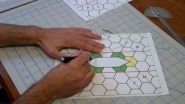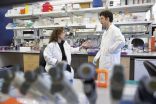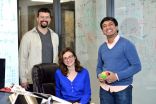Understanding how emotions ripple after terrorist acts
Pitt and Cornell researchers publish study on how Twitter users in 95 cities worldwide reacted to 2013 Boston Marathon bombing
2014-12-11
(Press-News.org) PITTSBURGH--The 2013 Boston Marathon bombing motivated mass expressions of fear, solidarity, and sympathy toward Bostonians on social media networks around the world. In a recently released study, researchers at the University of Pittsburgh and Cornell University analyzed emotional reactions on Twitter in the hours and weeks following the attack.
The study is the first large-scale analysis of fear and social-support reactions from geographically distant communities following a terrorist attack. The findings show the extent to which communities outside of Boston expressed their emotions by using hashtags such as #PrayForBoston and how those reactions correlated with geographic proximity, social-network connections, and direct ties to Boston.
The full results of the study, which have been published online in the journal EPJ Data Science, may provide insight to governmental agencies exploring how to best handle public fear following a disruptive event.
"When a community in one geographic location is attacked, it is important for government officials to be able to predict where public fears will be heightened most as a result of that attack. The findings of our study will potentially assist officials in predicting the exact manner and extent in which citizens in their own regions will react to tragic occurrences in another region of the country," said Yu-Ru Lin, the study's principal researcher and an assistant professor in Pitt's School of Information Sciences. "By swiftly recognizing the heightened presence of fear as a result of occurrences elsewhere, officials within a city can respond appropriately with various measures to calm the public and reassure them that all measures are being taken to ensure public safety and well-being."
The study is unique in that previous studies of emotional responses to terror attacks have only focused on those in directly affected areas. For the Pitt-led study, researchers analyzed more than 180 million geocoded tweets from individuals in 95 cities around the world. Researchers focused their analysis on the 60 most-populated metropolitan areas in the United States as well as the 35 highest-populated cities outside of the United States.
To study expressions of fear, Lin's team utilized content-analysis programs to search for a predetermined set of keywords--including "fearful," "fatal," and "terror,"--within tweets directly related to the bombing. The study also utilized Twitter hashtags to identify tweets reflecting expressions of solidarity and sympathy. Researchers found that citizens in some cities were more likely to express specific emotions based on geography and shared experiences.
The hashtag #PrayForBoston--a variant of the #PrayFor{X} hashtags that have been used in recent years following various tragic events--was used to identify expressions of sympathy. Citizens in the city of London were modest in their expressions of fear and solidarity but were more forthcoming in their use of the #PrayForBoston hashtag. Lin and her team theorized that the greater show of sympathy from Londoners was due to the citizens of London having endured their own terrorist attacks in the recent past and therefore relating to the sense of tragedy that Boston's citizens were enduring.
The hashtag #BostonStrong--a variant of the #{X}strong hashtags made popular by Lance Armstrong's Livestrong motto and the U.S. Army's "Army Strong" media campaign--was used to measure expressions of solidarity. Expressions of solidarity were used most by citizens in U.S. cities that possess close geographic proximity and have similar cultural identities as Boston. For instance, citizens in Chicago and Washington, D.C., were more likely to express emotions of solidarity due to their relative closeness in distance and personal ties with Boston.
"Our findings suggest that the immediate emotional reactions on social media are indicators of deeper feelings of connection to suffering in other communities that linger," said Drew Margolin, Lin's collaborator and an assistant professor of communication in the College of Agriculture and Life Sciences at Cornell University. "In the future, this may have implications for anticipating how communities will respond to shocking events beyond terrorist attacks, such as school shootings, natural disasters like Hurricane Sandy, or incidents like those that occurred in Ferguson, Missouri."
According to the study's overall findings, the extent to which communities outside of the Boston metropolitan area expressed emotional reactions to the attack directly correlated with individuals' geographic proximities, social network connections to Boston residents, and relationships to the city of Boston. Furthermore, reactions of fear were the most likely of sentiments to be expressed by individuals with direct ties to Boston or to Bostonians. The extent to which individuals had ties to the Boston area was the best predictor of fear and solidarity expression as well as a strong predictor of an expression of sympathy.
INFORMATION:
The paper "The ripple of fear, sympathy and solidarity during the Boston bombings" is available online in EPJ Data Science.
ELSE PRESS RELEASES FROM THIS DATE:
2014-12-11
Origami is capable of turning a simple sheet of paper into a pretty paper crane, but the principles behind the paper-folding art can also be applied to making a microfluidic device for a blood test, or for storing a satellite's solar panel in a rocket's cargo bay.
A team of University of Pennsylvania researchers is turning kirigami, a related art form that allows the paper to be cut, into a technique that can be applied equally to structures on those vastly divergent length scales.
In a new study, the researchers lay out the rules for folding and cutting a hexagonal ...
2014-12-11
A CEO's natural sunny disposition can have an impact on the way the market reacts to announcements of company earnings, according to research from the University of British Columbia's Sauder School of Business.
The study shows that leaders' inclinations to express themselves with optimism carries over into their tone when disclosing company performance - a tendency that can create an uptick in stock price.
"Ours is the first study to look at the effect of how managers naturally convey themselves," says Sauder Assistant Professor Jenny Zhang, who co-authored the paper. ...
2014-12-11
Senescent cells have a bad-guy reputation when it comes to aging. While cellular senescence - a process whereby cells permanently lose the ability to divide when they are stressed - suppresses cancer by halting the growth of premalignant cells, it is also suspected of driving the aging process. Senescent cells, which accumulate over time, release a continual cascade of inflammatory cytokines, chemokines, growth factors and proteases. It is a process that sets up the surrounding tissue for a host of maladies including arthritis, atherosclerosis and late life cancer. But ...
2014-12-11
The ascetic and moralizing movements that spawned the world's major religious traditions--Buddhism, Islam, Judaism, Hinduism, and Christianity--all arose around the same time in three different regions, and researchers reporting in the Cell Press journal Current Biology on December 11 have now devised a statistical model based on history and human psychology that helps to explain why. The emergence of world religions, they say, was triggered by the rising standards of living in the great civilizations of Eurasia.
"One implication is that world religions and secular spiritualities ...
2014-12-11
EMBARGOED for release Thursday, Dec. 11, 2014, at 12 p.m. ET
HOUSTON - (Dec. 11, 2014) - The ancient Japanese art of origami is based on the idea that nearly any design - a crane, an insect, a samurai warrior - can be made by taking the same blank sheet of paper and folding it in different ways.
The human body faces a similar problem. The genome inside every cell of the body is identical, but the body needs each cell to be different -an immune cell fights off infection; a cone cell helps the eye detect light; the heart's myocytes must beat endlessly.
Appearing online ...
2014-12-11
Clinical trials to test the new drugs in patients should begin as early as 2015.
Existing drugs target faulty versions of a protein called BRAF which drives about half of all melanomas, but while initially very effective, the cancers almost always become resistant to treatment within a year.
The new drugs - called panRAF inhibitors - could be effective in patients with melanoma who have developed resistance to BRAF inhibitors.
The new study was funded by the Wellcome Trust and Cancer Research UK, and jointly led by scientists at The Institute of Cancer Research, ...
2014-12-11
Scientists at the University of Southampton have found that the precise shape of an antibody makes a big difference to how it can stimulate the body's immune system to fight cancer, paving the way for much more effective treatments.
The latest types of treatment for cancer are designed to switch on the immune system, allowing the patient's own immune cells to attack and kill cancerous cells, when normally the immune cells would lie dormant.
In a study, funded by Cancer Research UK and published in the journal Cancer Cell, the Southampton team have found that a particular ...
2014-12-11
PHILADELPHIA - (Dec. 11, 2014) - A team of scientists, led by researchers at The Wistar Institute, has found that an infection with herpes simplex virus 1 (HSV-1) causes rearrangements in telomeres, small stretches of DNA that serve as protective ends to chromosomes. The findings, which will be published in the Dec. 24 edition of the journal Cell Reports, show that this manipulation of telomeres may explain how viruses like herpes are able to successfully replicate while also revealing more about the protective role that telomeres play against other viruses.
"We know ...
2014-12-11
The saga of the Osedax "bone-eating" worms began 12 years ago, with the first discovery of these deep-sea creatures that feast on the bones of dead animals. The Osedax story grew even stranger when researchers found that the large female worms contained harems of tiny dwarf males.
In a new study published in the Dec. 11 issue of Current Biology, marine biologist Greg Rouse at Scripps Institution of Oceanography at UC San Diego and his collaborators reported a new twist to the Osedax story, revealing an evolutionary oddity unlike any other in the animal kingdom. Rouse's ...
2014-12-11
HOUSTON -- (Dec. 11, 2014) -- In a triumph for cell biology, researchers have assembled the first high-resolution, 3-D maps of entire folded genomes and found a structural basis for gene regulation -- a kind of "genomic origami" that allows the same genome to produce different types of cells. The research appears online today in Cell.
A central goal of the five-year project, which was carried out at Baylor College of Medicine, Rice University, the Broad Institute and Harvard University, was to identify the loops in the human genome. Loops form when two bits of DNA that ...
LAST 30 PRESS RELEASES:
[Press-News.org] Understanding how emotions ripple after terrorist acts
Pitt and Cornell researchers publish study on how Twitter users in 95 cities worldwide reacted to 2013 Boston Marathon bombing



